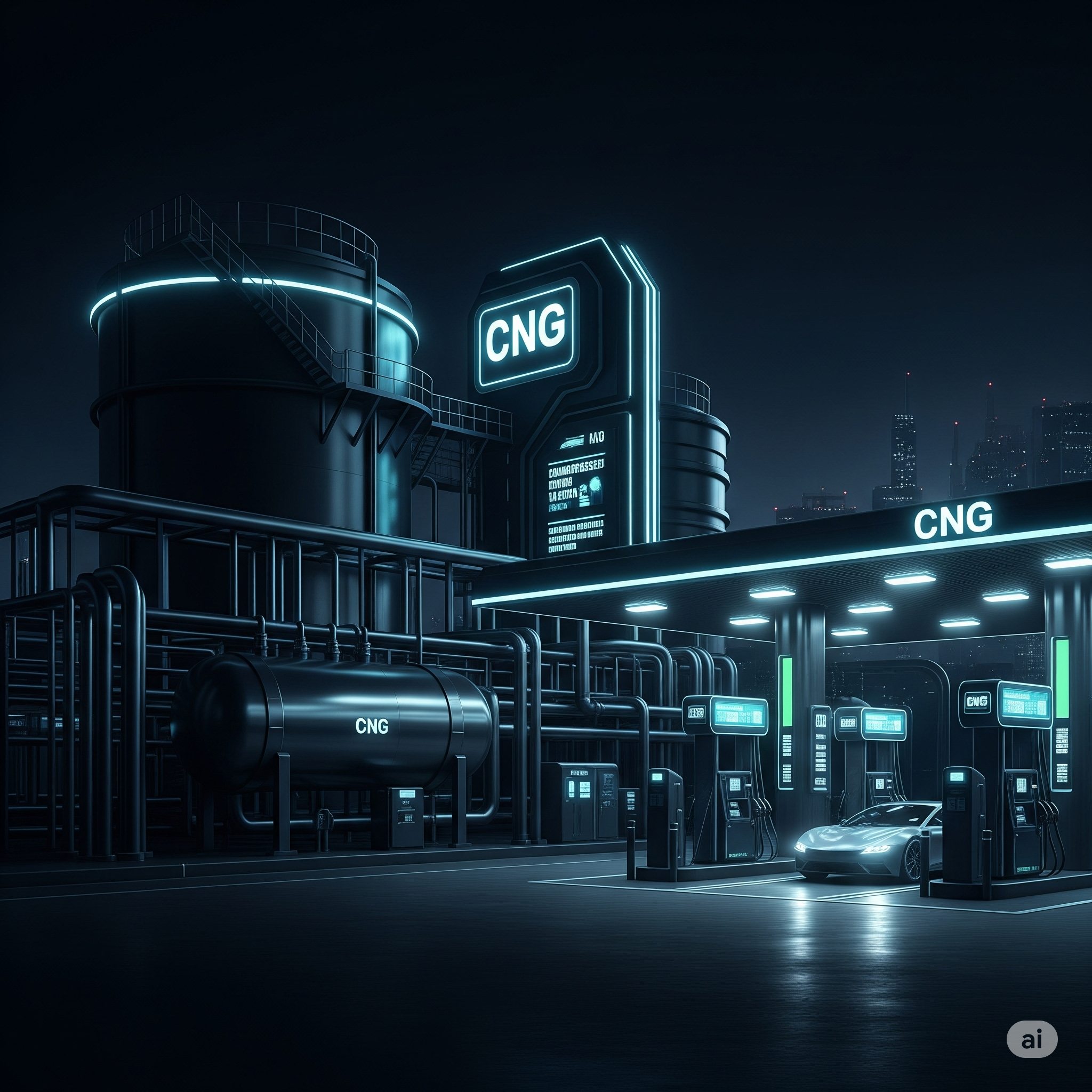The global demand for cleaner fuels and sustainable transportation has significantly increased the focus on Compressed Natural Gas (CNG) as an alternative to conventional fuels like petrol and diesel. CNG offers multiple advantages, including lower emissions, cost efficiency, and improved urban air quality. However, widespread adoption of CNG as a mainstream fuel is largely dependent on robust infrastructure. This article examines the current state, challenges, and opportunities of CNG infrastructure, providing a comprehensive understanding for policymakers, investors, and students studying sustainable energy systems.
1. Understanding CNG and Its Infrastructure
1.1 What is Compressed Natural Gas (CNG)?
CNG is primarily composed of methane (CH₄) and is stored at high pressure, typically 200–250 bar. It is used as a fuel in modified internal combustion engines, offering a cleaner alternative to petrol and diesel. CNG can be sourced from natural gas pipelines, liquefied natural gas (LNG), or renewable sources like biogas.
1.2 Components of CNG Infrastructure
CNG infrastructure consists of several key components:
- Supply and Storage:
- Natural Gas Pipelines: Transportation of raw gas to refueling stations.
- CNG Compressors: Compress gas to high pressure suitable for storage and vehicle fueling.
- Storage Cylinders: Store compressed gas at stations and in vehicles.
- Natural Gas Pipelines: Transportation of raw gas to refueling stations.
- Refueling Stations:
- Retail CNG Stations: Serve public vehicles, taxis, buses, and private cars.
- Fast-Fill Stations: High-capacity stations that quickly refill commercial and fleet vehicles.
- Home/Private CNG Solutions: Limited adoption due to safety and technical challenges.
- Vehicle Integration:
- CNG Vehicles: Factory-fitted or retrofitted vehicles with high-pressure storage cylinders.
- Fleet Management Systems: Ensure availability and distribution for commercial vehicles.
- Safety and Monitoring Systems:
- Leak detection, pressure regulators, fire suppression, and regular inspection systems ensure safe handling of high-pressure gas.
2. Global and National Context of CNG Infrastructure
2.1 Global Adoption
Countries like Argentina, Italy, Brazil, and Pakistan have extensive CNG infrastructure. In these nations:
- CNG is widely used in taxis, buses, and light commercial vehicles.
- Government incentives, such as tax benefits and subsidies, have accelerated infrastructure growth.
- High population density urban centers prioritize CNG to reduce pollution and dependency on diesel.
2.2 Indian Scenario
India has emerged as a significant market for CNG adoption, driven by environmental policies and urban air pollution challenges:
- Delhi Model: Mandatory CNG adoption for public transport vehicles drastically improved air quality.
- Other Metro Cities: Mumbai, Pune, and Bengaluru are expanding CNG refueling stations.
- Government Initiatives: Subsidies, tax incentives, and policy frameworks aim to expand CNG infrastructure under initiatives like the PNGRB (Petroleum and Natural Gas Regulatory Board) CNG expansion plan.
Despite progress, coverage remains limited in rural and semi-urban areas, creating both challenges and opportunities for expansion.
3. Challenges in CNG Infrastructure Development
3.1 Limited Refueling Network
The most significant barrier to CNG adoption is insufficient refueling stations, particularly outside major cities. Challenges include:
- High Initial Investment: Setting up a CNG station involves costs for compressors, storage cylinders, pipelines, and safety systems, making it capital-intensive.
- Land Acquisition Issues: Urban areas face space constraints, making station placement difficult.
- Pipeline Connectivity: Many areas lack natural gas pipeline infrastructure, which limits the ability to supply CNG stations reliably.
3.2 Technical Challenges
CNG requires specialized technical solutions to ensure safe and efficient operations:
- High-Pressure Storage: Compressors and cylinders must withstand extreme pressures, requiring robust materials and maintenance.
- Vehicle Compatibility: Older petrol/diesel vehicles may require expensive conversion kits for CNG, discouraging adoption.
- Maintenance Requirements: Frequent inspection of cylinders and leak detection systems is mandatory to prevent accidents.
3.3 Safety Concerns
Public perception of safety is a major factor limiting adoption:
- Methane is highly flammable, and improper handling can result in accidents.
- Inadequate training of station personnel and vehicle owners can lead to safety incidents.
- Urban stations need strict adherence to fire codes, safety clearances, and emergency response protocols.
3.4 Policy and Regulatory Hurdles
Inconsistent policies can slow infrastructure development:
- Variations in state-level regulations for station approvals and pipeline construction.
- Lack of uniform safety and operational standards across regions.
- Delays in regulatory approvals for new stations.
3.5 Market and Demand Challenges
CNG infrastructure development depends on sufficient vehicle adoption:
- Low penetration of CNG vehicles in some regions reduces station viability.
- Fleet operators may be reluctant to switch to CNG due to initial costs and logistical challenges.
- Fuel pricing policies and subsidies significantly influence demand.
4. Opportunities in CNG Infrastructure Development
4.1 Urban Pollution Control
CNG infrastructure provides a direct solution to urban air pollution:
- Cities can reduce PM2.5, NOx, and CO emissions by promoting CNG buses, taxis, and delivery vehicles.
- Governments can implement low-emission zones and encourage fleet operators to transition to CNG.
- Investment in CNG refueling networks ensures consistent supply for urban mobility.
4.2 Cost Benefits for Consumers
CNG is cheaper than petrol and diesel per kilometer, offering opportunities for mass adoption:
- Lower running costs attract fleet operators, commercial transport, and ride-sharing services.
- Subsidies and tax benefits reduce initial conversion costs, making adoption financially viable.
- Long-term fuel savings incentivize investment in infrastructure development.
4.3 Integration with Renewable Energy
Opportunities exist to produce Bio-CNG from agricultural residues, organic waste, and sewage:
- Bio-CNG provides a carbon-neutral fuel, reducing reliance on fossil natural gas.
- Infrastructure for Bio-CNG can use existing CNG stations, offering scalability.
- Waste-to-energy projects promote sustainable urban planning and circular economy principles.
4.4 Technological Advancements
Innovations in CNG infrastructure are creating new opportunities:
- Fast-Fill Compressors: Reduce refueling time for commercial fleets.
- Lightweight Cylinders: Improve vehicle fuel efficiency and safety.
- IoT and Smart Monitoring: Leak detection, automated pressure control, and maintenance alerts enhance safety and operational efficiency.
- Dual-Fuel Systems: Vehicles capable of running on both petrol and CNG increase flexibility and reduce range anxiety.
4.5 Public-Private Partnerships (PPP)
Collaboration between governments and private companies can accelerate infrastructure development:
- Private players invest in stations while governments provide land, policy support, and tax incentives.
- PPP models reduce the financial burden on a single stakeholder and ensure sustainable operations.
- Successful PPP projects in cities like Delhi, Mumbai, and Pune demonstrate scalability for other regions.
4.6 Export of Expertise and Technology
Countries with established CNG infrastructure can export technology, training, and consulting services:
- Compressed gas station designs, vehicle conversion technology, and safety protocols can be adopted globally.
- International collaboration encourages standardized infrastructure development and reduces costs.
5. Strategic Planning for CNG Infrastructure Expansion
5.1 Mapping Demand and Supply
A comprehensive infrastructure plan requires data-driven insights:
- Identify high-density urban corridors and industrial areas with vehicle fleets.
- Analyze vehicle types (buses, taxis, private cars) and fuel consumption patterns.
- Plan station placement to minimize travel distance for refueling.
5.2 Phased Expansion Approach
Gradual rollout ensures sustainable growth:
- Urban Focus: Start with high-demand urban centers to maximize air quality benefits.
- Highway Networks: Expand along intercity corridors to enable long-distance CNG vehicle travel.
- Rural Outreach: Gradual expansion with Bio-CNG options to ensure inclusivity and sustainability.
5.3 Incentives for Stakeholders
Encouraging investment requires targeted incentives:
- Private Sector: Subsidies, tax rebates, and low-interest loans for station setup.
- Fleet Operators: Reduced vehicle conversion costs, discounted fuel, and access to dedicated stations.
- Public Awareness: Campaigns highlighting cost savings, environmental benefits, and safety measures.
5.4 Safety and Standards
Robust standards are critical:
- National safety codes for refueling stations, cylinders, and compressors.
- Regular audits and certifications to ensure compliance.
- Training programs for personnel and emergency preparedness drills.
6. Case Studies and Best Practices
6.1 Delhi, India
- Mandatory CNG adoption for public buses, taxis, and autorickshaws.
- Over 500 CNG refueling stations established in the city.
- Significant reduction in air pollutants and improved public health outcomes.
6.2 Argentina
- One of the largest CNG vehicle markets globally.
- Government incentives and private investment created a dense refueling network.
- Successful integration of CNG in both passenger and commercial fleets.
6.3 Italy
- Over 1 million CNG vehicles supported by extensive infrastructure.
- Focus on urban buses and private vehicles with well-regulated safety and operational standards.
- Integration of renewable CNG (biogas) is underway to enhance sustainability.
7. Future Outlook of CNG Infrastructure
7.1 Transition Fuel for Sustainable Mobility
CNG serves as a bridge between conventional fossil fuels and zero-emission technologies:
- Reduces air pollution while EV infrastructure matures.
- Supports hybrid systems where CNG can complement battery or electric vehicles.
- Promotes circular economy with Bio-CNG production from organic waste.
7.2 Investment Opportunities
Infrastructure expansion offers economic benefits:
- Entrepreneurs can invest in refueling stations, vehicle conversion, and fleet operations.
- Government-backed schemes lower entry barriers and enhance returns.
- Integration with renewable energy projects creates additional revenue streams.
7.3 Technological Integration
- IoT-enabled smart stations for real-time monitoring.
- Automated compressors and mobile apps for vehicle refueling.
- Safety enhancements such as predictive maintenance and leak detection.
7.4 Environmental and Policy Support
- National policies incentivize low-emission transport solutions.
- Urban centers increasingly prioritize air quality improvement projects.
- Alignment with Sustainable Development Goals (SDGs) strengthens social and environmental impact.
8. Conclusion
CNG infrastructure development presents both significant challenges and immense opportunities. Key challenges include limited refueling networks, high initial investment, technical and safety requirements, and policy inconsistencies. However, the benefits of CNG infrastructure—urban pollution control, climate change mitigation, cost savings, and sustainable mobility—make it a viable and attractive solution for modern transportation needs.
Opportunities abound in urban areas, fleet operations, bio-CNG production, and technological innovation. Governments and private sector collaboration can accelerate adoption, ensuring cleaner air, reduced greenhouse gas emissions, and a sustainable transport future.
In conclusion, while establishing CNG infrastructure requires careful planning, investment, and regulatory oversight, its environmental, economic, and social benefits make it a strategic priority for cities and countries aiming for sustainable development. The future of urban mobility and cleaner transportation will likely rely on the expansion and optimization of CNG infrastructure, complementing the broader transition to electric and renewable fuels.




